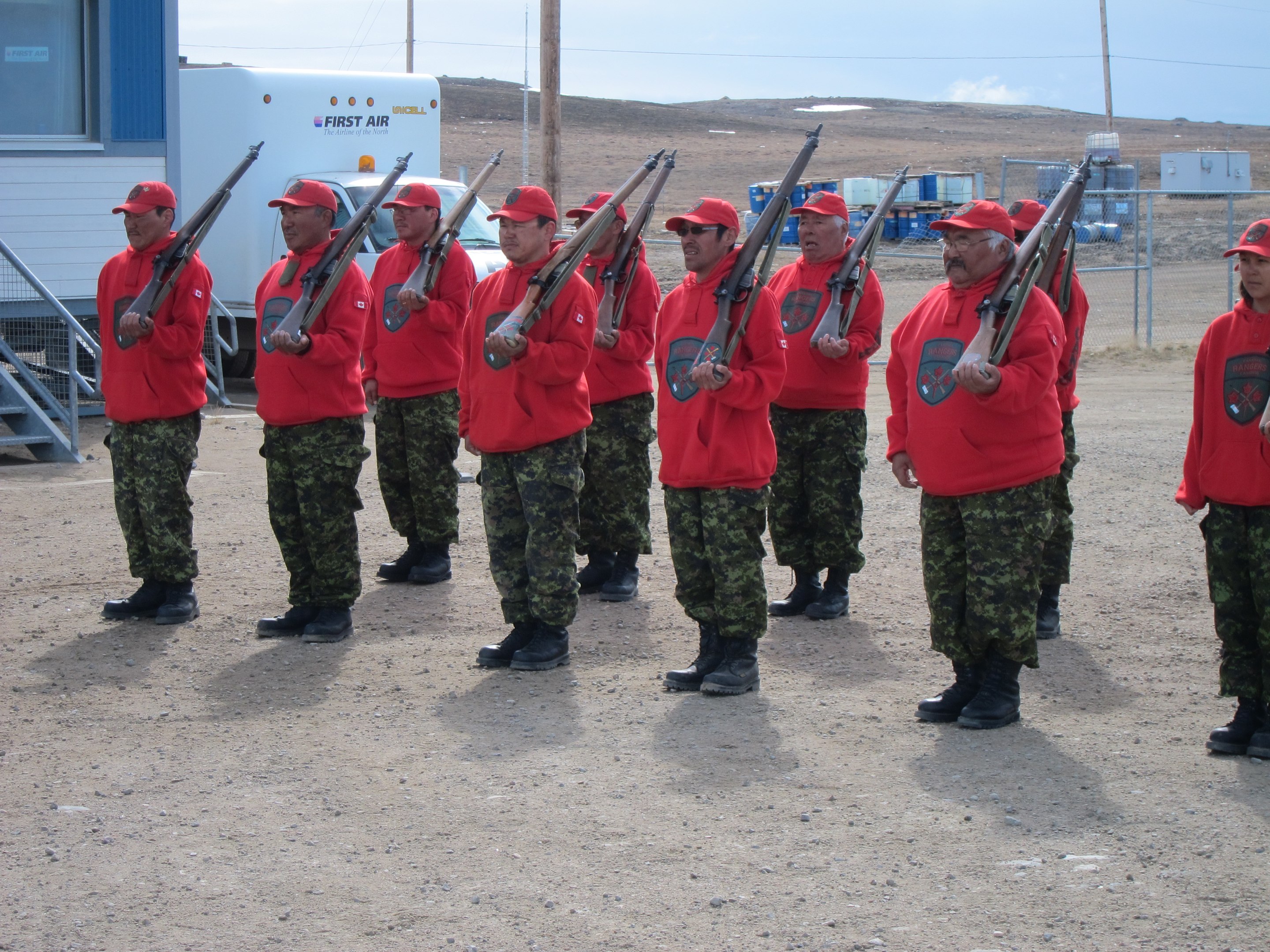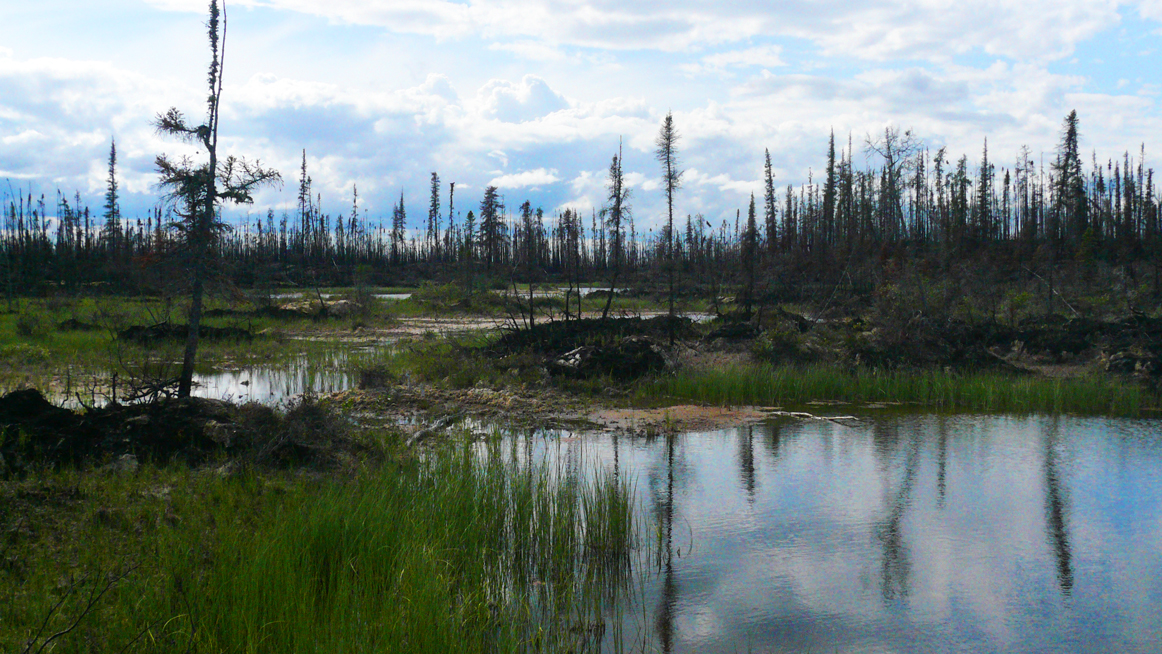|
1 Canadian Ranger Patrol Group
No. 1 Canadian Ranger Patrol Group is a patrol group of the Canadian Rangers. The Rangers have provided a visible military presence in isolated, coastal and northern communities for over 65 years and continue to serve as the military's "eyes, ears and voice" of the North. 1 CRPG's motto "Vigilans," which translated means "The Watchers," reflects how the Rangers continue to guard their local areas and provide support to the Canadian Armed Forces during domestic operations across the North. History No. 1 Canadian Ranger Patrol Group (1 CRPG) traces its origin to the Pacific Coast Militia Rangers (PCMR), formed as coast watchers in 1942 and stood down at the end of the Second World War. Soon after the war ended, senior defence officials decided that the Ranger concept was still valid and decided to expand it to include all stretches of Canada's coastline: the Pacific, the Arctic, and the Atlantic. Accordingly, the Canadian Rangers were officially formed as a Corps of t ... [...More Info...] [...Related Items...] OR: [Wikipedia] [Google] [Baidu] |
Canadian Rangers
, colors =Red and green , march = , mascot = , battles = Second World WarCold War , anniversaries = , notable_commanders = , identification_symbol_2_label = , current_commander = Lieutenant-General Jean-Marc Lanthier, Commander of the Canadian Army , ceremonial_chief = , ceremonial_chief_label = , colonel_of_the_regiment = , website = , identification_symbol = , identification_symbol_label = NATO Map Symbol(2017) The Canadian Rangers (french: links=no, Rangers canadiens) are a 5,000-strong sub-component of the Canadian Armed Forces reserve that provide a limited military presence in Canada's sparsely settled northern, coastal, and isolated areas where it would not be economically or practically viable to have conventional Army units. Formally established on May 23, 1947, a primary role of this part-time force is to conduct surveillance or sovereignty patrols (SOV PATS) as required. Some Canadian Rangers also conduct inspections of the North Warning System (N ... [...More Info...] [...Related Items...] OR: [Wikipedia] [Google] [Baidu] |
Twin Otter
The de Havilland Canada DHC-6 Twin Otter is a Canadian STOL (Short Takeoff and Landing) utility aircraft developed by de Havilland Canada, which produced the aircraft from 1965 to 1988; Viking Air purchased the type certificate, then restarted production in 2008 before re-adopting the DHC name in 2022. The aircraft's fixed tricycle undercarriage, STOL capabilities, twin turboprop engines and high rate of climb have made it a successful commuter airliner, typically seating 18-20 passengers, as well as a cargo and medical evacuation aircraft. In addition, the Twin Otter has been popular with commercial skydiving operations, and is used by the United States Army Parachute Team and the United States Air Force's 98th Flying Training Squadron. Design and development Development of the aircraft began in 1964, with the first flight on May 20, 1965. A twin-engine replacement for the single-engine DHC-3 Otter retaining DHC's STOL qualities, its design features included double-slotte ... [...More Info...] [...Related Items...] OR: [Wikipedia] [Google] [Baidu] |
Gamèti
Gamètì (; formerly known as Rae Lakes until 4 August 2005), officially the ''Tłı̨chǫ Community Government of Gamètì'' is a community in the North Slave Region of the Northwest Territories, Canada. Gamètì, according to the Prince of Wales Northern Heritage Centre means "rabbit-net lake". 'Gamè' means 'rabbit', and 'tì' means lake, or water. It is one of the four Tłı̨chǫ communities which form part of the Tlicho Government. History The area is within the traditional territory of the Tłı̨chǫ (Dogrib) First Nations and was a popular hunting camp prior to permanent settlement. In the 1960s, Dene elders around Behchokǫ̀ decided to return to the land and establish traditional camps in the bush. Gamètì was established during this time, although in more recent years it too has become a modern community with essential services of its own. The community was officially known as ''Rae Lakes'' until August 4, 2005. Before 2005, the community was unincorporated, and lo ... [...More Info...] [...Related Items...] OR: [Wikipedia] [Google] [Baidu] |
Whatì
Whatì (; from the Dogrib language meaning "Marten Lakes"), officially the ''Tłı̨chǫ Community Government of Whatì'' is a First Nations community in the North Slave Region of the Northwest Territories, Canada. Whatì is located by Lac La Martre, about northwest of the territorial capital of Yellowknife. History With rich and varied wildlife, the area has long been a favoured hunting ground of the Tłı̨chǫ (Dogrib Dene) Indigenous people. The North West Company established a trading post there in 1793, and many natives began settling there permanently, while they continued to hunt and fish in the area. With the establishment of a trading post at Fort Rae on Great Slave Lake in the late 19th century, most regional trading was accomplished at the Hudson's Bay Company and free traders posts there. A trading post at Lac La Martre was not again established until the 1920s. On January 1, 1996, the community officially changed its name from Lac La Martre to the Tłı̨chǫ ... [...More Info...] [...Related Items...] OR: [Wikipedia] [Google] [Baidu] |
Fort Smith, Northwest Territories
Fort Smith ( chp, Thebacha "beside the rapids") is a town in the South Slave Region of the Northwest Territories (NWT), Canada. It is located in the southeastern portion of the Northwest Territories, on the Slave River and adjacent to the Alberta border along the 60th parallel north. History Fort Smith was founded around the Slave River. It served a vital link for water transportation between southern Canada and the western Arctic. Early fur traders found an established portage route from what is now Fort Fitzgerald on the western bank of the Slave River to Fort Smith. This route allowed its users to navigate the four sets of impassable rapids (Cassette Rapids, Pelican Rapids, Mountain Rapids, and Rapids of the Drowned). The portage trail had been traditionally used by local Indigenous people for centuries. The Indigenous population of the region shifted as the fortunes of the tribes changed. By 1870, Cree had occupied the Slave River Valley. The Slavey had moved north by t ... [...More Info...] [...Related Items...] OR: [Wikipedia] [Google] [Baidu] |
Fort Resolution
Fort Resolution (''Denı́nu Kų́ę́'' (pronounced "deh-nih-noo-kwenh") "moose island place") is a hamlet in the South Slave Region of the Northwest Territories, Canada. The community is situated at the mouth of the Slave River, on the shores of Great Slave Lake, and at the end of the Fort Resolution Highway (Highway 6). It is the headquarters of the Deninu Kųę́ First Nation, whose Chief is Louis Balsillie. It is the oldest documented European community in the Northwest Territories, built in 1819, and was a key link in the fur trade's water route north. Fort Resolution is designated as a National Historic Site of Canada as the oldest continuously occupied place in the Northwest Territories with origins in the fur trade and the principal fur trade post on Great Slave Lake. Fort Resolution's Deninoo School offers K-12 schooling. The town also has a hockey arena, community hall, a nursing station, a youth centre, Royal Canadian Mounted Police, a bed and breakfast, a 'Northern' ... [...More Info...] [...Related Items...] OR: [Wikipedia] [Google] [Baidu] |
Fort Simpson
Fort Simpson (Slavey language: ''Łı́ı́dlı̨ı̨ Kų́ę́'' "place where rivers come together") is a village, the only one in the entire territory, in the Dehcho Region of the Northwest Territories, Canada. The community is located on an island at the confluence of the Mackenzie River, Mackenzie and Liard River, Liard rivers. It is approximately west of Yellowknife. Both rivers were traditionally trade routes for the Hudson's Bay Company and the native Dene people of the area. Fort Simpson is the regional centre of the Dehcho and is the gateway to the scenic South Nahanni River and the Nahanni National Park Reserve. Fort Simpson can be reached by air, water and road and has full secondary school, secondary and elementary school service. The Mackenzie Highway was extended to Fort Simpson in 1970-71. The central section of the community is on an island near the south bank of the Mackenzie River, but industrial areas and rural residential areas are located along the highway ... [...More Info...] [...Related Items...] OR: [Wikipedia] [Google] [Baidu] |
Behchokǫ̀
Behchokǫ̀ ( ɛ́ht͡ʃʰókʰõ̀or ɛ́ht͡sʰókʰõ̀ ) (from the Tłı̨chǫ meaning "Behcho's place"), officially the ''Tłı̨chǫ Community Government of Behchokǫ̀,'' is a community in the North Slave Region of the Northwest Territories, Canada. Behchokǫ̀ is located on the Yellowknife Highway (Great Slave Highway), on the northwest tip of Great Slave Lake, approximately northwest of Yellowknife. History The north arm of Great Slave Lake is the traditional territory of the Tłı̨chǫ (Dogrib), a northern Dene (formerly called Athapaskan) group. Explorer Samuel Hearne was the first European to encounter Dogrib-speaking people while crossing the lands north of Great Slave Lake in 1772. Later, in 1789, trader Alexander Mackenzie traveled by canoe very close to their territory while trading with the Yellowknives, another First Nations peoples, along the north arm of the big lake. The first trading post in this region was at the entrance of Yellowknife Bay, establis ... [...More Info...] [...Related Items...] OR: [Wikipedia] [Google] [Baidu] |
440 Transport Squadron
440 Transport Squadron is a unit of the Canadian Armed Forces under the Royal Canadian Air Force. It is part of 8 Wing and works closely with Joint Task Force (North) located in Yellowknife, Northwest Territories. Based at Yellowknife Airport and operating throughout Northern Canada, the unit's primary role is to provide support to the Canadian Forces, including the Canadian Rangers and the Royal Canadian Air Cadets, with search and rescue as a secondary role. The squadron operates four CC-138 DHC-6 Twin Otter aircraft that can flown on tundra tires, skis or floats, though, the float program was abandoned in 1999 when it was determined that there was not enough call for that capability in the CF. The squadron was founded in the 1930s as an army cooperation squadron. It was for a time an air defence squadron from the start of the Second World War before moving to the United Kingdom. There it equipped as a fighter-bomber squadron under Royal Air Force (RAF) operational control, ... [...More Info...] [...Related Items...] OR: [Wikipedia] [Google] [Baidu] |
1 CRPG Patrols
1 (one, unit, unity) is a number representing a single or the only entity. 1 is also a numerical digit and represents a single unit of counting or measurement. For example, a line segment of ''unit length'' is a line segment of length 1. In conventions of sign where zero is considered neither positive nor negative, 1 is the first and smallest positive integer. It is also sometimes considered the first of the infinite sequence of natural numbers, followed by 2, although by other definitions 1 is the second natural number, following 0. The fundamental mathematical property of 1 is to be a multiplicative identity, meaning that any number multiplied by 1 equals the same number. Most if not all properties of 1 can be deduced from this. In advanced mathematics, a multiplicative identity is often denoted 1, even if it is not a number. 1 is by convention not considered a prime number; this was not universally accepted until the mid-20th century. Additionally, 1 is the s ... [...More Info...] [...Related Items...] OR: [Wikipedia] [Google] [Baidu] |


.jpg)
.jpg)


